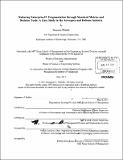| dc.contributor.advisor | Deborah Nightingale and Roy Welsch. | en_US |
| dc.contributor.author | Wheeler, Benjamin (Benjamin Ray) | en_US |
| dc.contributor.other | Leaders for Global Operations Program. | en_US |
| dc.date.accessioned | 2011-09-27T18:35:46Z | |
| dc.date.available | 2011-09-27T18:35:46Z | |
| dc.date.copyright | 2011 | en_US |
| dc.date.issued | 2011 | en_US |
| dc.identifier.uri | http://hdl.handle.net/1721.1/66041 | |
| dc.description | Thesis (M.B.A.)--Massachusetts Institute of Technology, Sloan School of Management; and, (S.M.)--Massachusetts Institute of Technology, Engineering Systems Division; in conjunction with the Leaders for Global Operations Program at MIT, 2011. | en_US |
| dc.description | Cataloged from PDF version of thesis. | en_US |
| dc.description | Includes bibliographical references (p. 60-61). | en_US |
| dc.description.abstract | Over the last several decades, manufacturing companies around the world have embraced new and powerful business tools made possible with Information Technology. Major investments are frequently made in enterprise-wide systems, such as Enterprise Resource Planning (ERP) solutions to take advantage of cost saving opportunities. While promising in concept, system implementations can grow to be expensive and complicated during execution, commonly resulting in project de-scoping and sacrifices in functionality and integration. If not carefully managed, this can ultimately lead to an environment of costly custom workaround solutions for years to follow, subverting the central goal of the original investment. This thesis presents a case study examining Raytheon's initiative to launch an enterprise ERP system (SAP PRISM) in an effort to standardize and modernize supply chain operations. Within the SAP implementation, the repair and retrofit, or depot, business had major integration components de-scoped due to cost constraints. As a result numerous systems have been developed to manage the business, leading to difficulties in process alignment across manufacturing programs. This work introduces a pilot project with the objective of re-aligning business processes by delivering a portal of common metrics and decision tools to the manufacturing and operations community. With the common portal, the user community gains access to existing centralized data, reducing the need for isolated application development and enabling richer capability. | en_US |
| dc.description.statementofresponsibility | by Benjamin Wheeler. | en_US |
| dc.format.extent | 61 p. | en_US |
| dc.language.iso | eng | en_US |
| dc.publisher | Massachusetts Institute of Technology | en_US |
| dc.rights | M.I.T. theses are protected by
copyright. They may be viewed from this source for any purpose, but
reproduction or distribution in any format is prohibited without written
permission. See provided URL for inquiries about permission. | en_US |
| dc.rights.uri | http://dspace.mit.edu/handle/1721.1/7582 | en_US |
| dc.subject | Sloan School of Management. | en_US |
| dc.subject | Engineering Systems Division. | en_US |
| dc.subject | Leaders for Global Operations Program. | en_US |
| dc.title | Reducing enterprise IT fragmentation through standard metrics and decision tools : a case study in the aerospace and defense industry | en_US |
| dc.type | Thesis | en_US |
| dc.description.degree | S.M. | en_US |
| dc.description.degree | M.B.A. | en_US |
| dc.contributor.department | Leaders for Global Operations Program at MIT | en_US |
| dc.contributor.department | Massachusetts Institute of Technology. Engineering Systems Division | |
| dc.contributor.department | Sloan School of Management | |
| dc.identifier.oclc | 752298002 | en_US |
